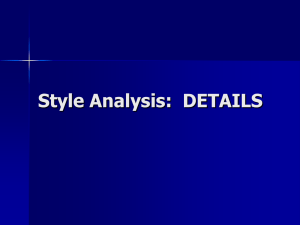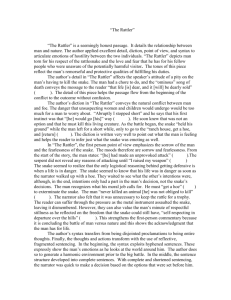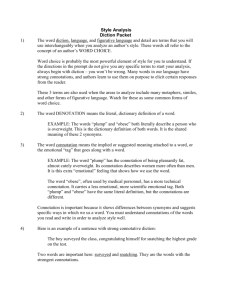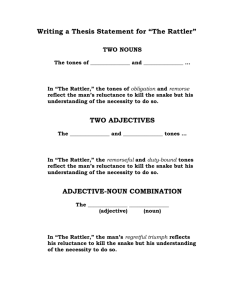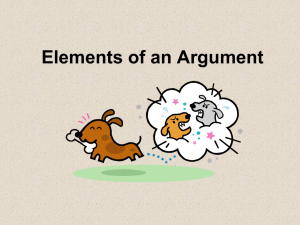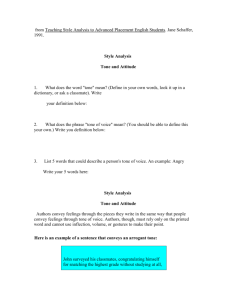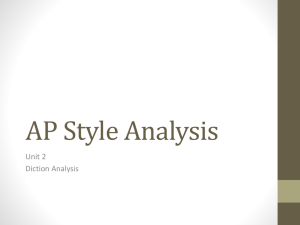AP Style Analysis Unit 3 Detail_Imagery
advertisement
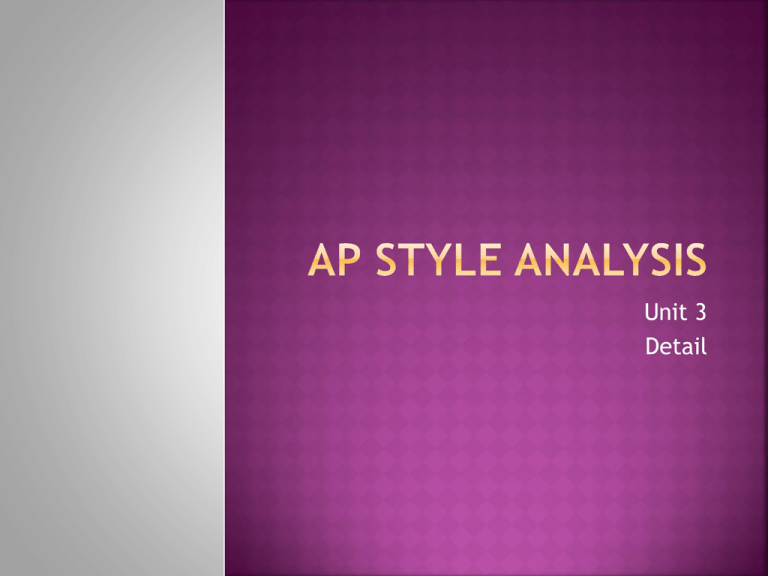
Unit 3 Detail The terms detail and imagery describe phrases that include literal or factual description. Detail is literal – who, what, when. Where diction refers to connotative vocabulary, detail refers to literal description. Here is a detail citation from “The Rattler”: “turned a little to watch what I would do” The phrase supplies concrete detail to the reader. It is important not for any connotations the words themselves may have but for the literal images of the scene between the man and the snake. This sentence helps us visualize the snake turning around as it sits on the desert sand. Read “The Rattler” again with your teacher. Circle, underline, or highlight any examples of detail or imagery that strike you as significant. Here are several phrases you can use as an example: “After sunset…I walked out into the desert” “I stopped” “turned a little to watch what I would do” “he was not even rattling yet, much less was he coiled” Now it is time to turn to the detail paragraph. Before you start, you need a topic sentence for it. The sentence should include the word detail and give a focus for the paragraph. Here is a sample topic sentence for this detail paragraph: The author’s detail illuminates the standoff and subsequent duel between the man and the snake. Just as you did with the diction, you will write an example sentence. There is one difference in the example sentence here: you will include only two quotations because detail and imagery require more words than diction to convey and idea. Here is an example: The snake “[turns] a little to watch” the man as he waits to see if he will go “back to the ranch house, [get] a hoe, and [return].” The quotation sentence integrates separate quotes taken from different parts of the passage. This shows your reader that you have understood the entire piece and are choosing quotations thoughtfully. Now look over the words and phrases you identified, and practice writing a quotation sentence of your own. The next step is to write commentary (analysis or interpretation) for the two quotes you included in your sample sentence. This should comment on the images conveyed by the detail. Commentary DOES NOT mean paraphrasing the quotation in the sentence; it means thinking about the effect of the images suggested by the detail. You will not be doing your own commentary in this exercise; we are including a sample to show you how this works. The chart on the next slide shows you how to write your quotes and commentary thoughts to create at least two chunks; your paragraph may have three chunks if you have time and more to say. TOPIC SENTENCE FOR DETAIL PARAGRAPH: The author’s detail illuminates the standoff and subsequent duel between the man and the snake. QUOTATION COMMENTARY • “turned a little to watch” • not afraid or hesitant • casual reaction to trivial interruption • go “back to the ranch house, [get] a hoe, and [return]” • calm watching of a possible threat You will not be doing your own version of the detail paragraph for “The Rattler.” you will practice with Fredrick Douglass later. On the next page is a sample of the first three paragraphs of this sample essay – the introduction, the diction paragraph, and the detail paragraph. In “The Rattler,” the tones of obligation and remorse reflect the man’s reluctance to kill the snake but his understanding of the necessity to do so. Despite his guarded admiration for an opponent and his personal code of honor toward nature, he remains detached from his desire to see the snake go free. He acknowledges his duty to others on the ranch but achieves, at best, a regretful triumph with the snakes demise. The author’s diction heightens the power and the force behind the snake as it responds to the man, first placidly, then aggressively. “Arrested,” the snake becomes a “live wire” after he shakes his “little tocsin” at the man. Unmoving at first, the snake plays a waiting game as adversary meets adversary across an imaginary line drawn in the desert. Then a feeling of electricity jolts the reader, heart beating faster from the noise of the warning that, like battle stations aboard a ship, calls all to readiness. Yet it must lose; despite its attempts to retreat to a “paper-bag bush,” the snake knows its life has been “dearly sold,” but it remains “sinuous and self-respecting” in the man’s mind. The hiding place is an illusion, and a costly one. The snake’s valiant behavior adds dignity to its last moments. All involved recognize the strength of both the man and the almost-human snake but know that responsibility and commitment to others make the killing necessary. The author’s detail illuminates the standoff and subsequent duel between the man and the snake. The snake “[turns] a little” to watch the man as he waits to see if he will go “back in the ranch house, [get] a hoe, and [return].” The snake is not afraid, hesitant, or easily unnerved because it knows its own formidable power. It moves its head casually, glancing over to see what interesting but trivial intrusion has arrived. After the man kills the reptile, he “does not cut the rattles off” but instead lets the snake “drop into the bush.” He does not want to take its life and feels no satisfaction in its death. The man’s respectful actions in response to the dignified presence of the snake are worthy. As he performs his distasteful and necessary task, he mourns the loss of grandeur and nobility. Reread your introduction for Fredrick Douglass. Underline, circle, or highlight the details in the passage. Discuss. Complete the detail chart. You will see the chart has space for four quotations. You must fill in all the boxes so that you have the required number of citations. TOPIC SENTENCE FOR DETAIL PARAGRAPH: ____________________________________________ ____________________________________________ QUOTATION COMMENTARY 1. 1. 2. 2. 3. 3. 4. 4. Discuss. Do the first half of the paragraph – one example sentence that integrates quotations and two commentary sentences. Read aloud. Now, do the second half of the paragraph – another example sentence that integrates quotations and two commentary sentences. Discuss. Now write a concluding sentence that gives a finished feeling to the paragraph. Now practice with the Henry James passage and the McWhirr passage.
